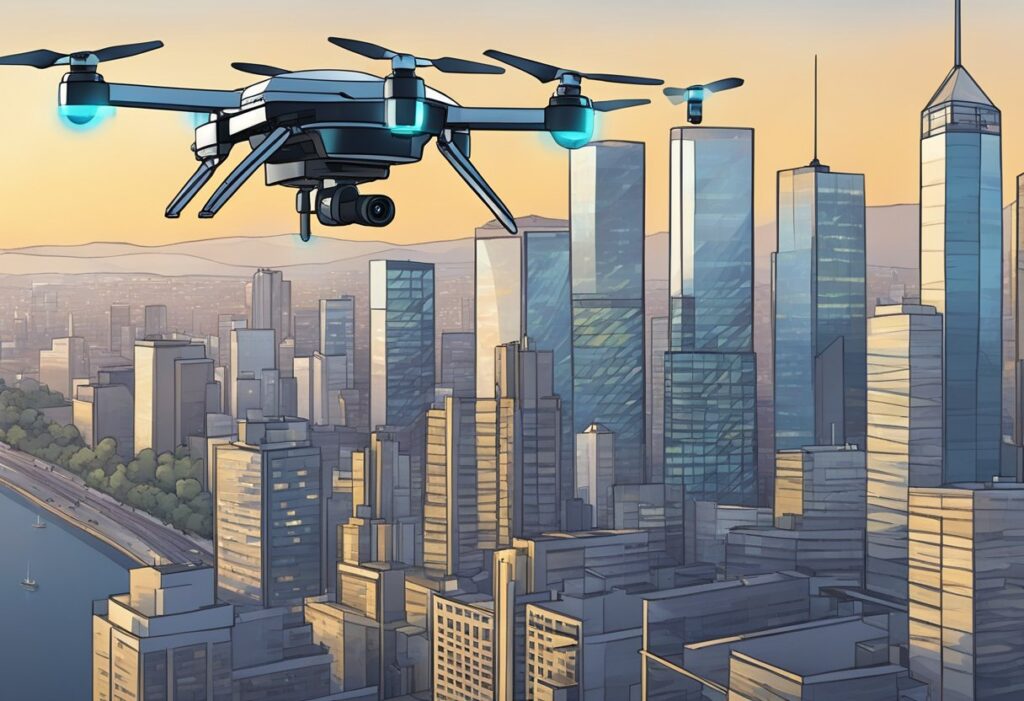Definition of AI in Policing

Artificial Intelligence (AI) in policing refers to the deployment of advanced computational technologies to enhance various aspects of law enforcement. This encompasses:
- Predictive analytics
- Facial recognition
- Crime analysis
- Risk assessment tools
These tools aim at improving the efficiency, accuracy, and overall effectiveness of police work.
Importance of AI in Law Enforcement
In an era where crime is becoming increasingly sophisticated, the importance of AI in law enforcement cannot be overstated. These technologies provide critical support to police departments, enabling them to combat crime more proactively and efficiently. AI’s capacity to analyze vast amounts of data in real-time significantly augments traditional policing methods, making communities safer and law enforcement more responsive.
Applications of AI in Policing
Predictive Policing
Predictive policing uses AI algorithms to analyze historical crime data and forecast where crimes are likely to occur. By identifying patterns and hotspots, police can allocate their resources more strategically, potentially preventing crimes before they happen. This proactive approach is revolutionizing how police departments plan their patrols and interventions.
Facial Recognition

Facial recognition technology leverages AI to match faces captured on video surveillance with databases of known individuals. This tool is invaluable for:
- Identifying suspects
- Finding missing persons
- Verifying identities in real-time
Its precision and speed provide a significant edge in solving crimes quickly and accurately.
Crime Analysis and Detection
AI enhances crime analysis by processing vast amounts of data from various sources, including:
- Social media
- Public records
- Surveillance footage
This comprehensive analysis helps detect criminal networks, uncover hidden patterns, and predict future criminal activities. It transforms raw data into actionable intelligence, facilitating more informed decision-making.
Risk Assessment Tools
Risk assessment tools powered by AI evaluate the likelihood of individuals reoffending or becoming involved in criminal activities. These tools aid in:
- Making more objective decisions regarding bail, parole, and sentencing
- Prioritizing cases
- Allocating resources to the most critical areas
Benefits of AI in Policing

Improved Efficiency and Resource Allocation
AI optimizes resource allocation by providing insights into where and when crimes are most likely to occur. This allows police departments to:
- Deploy officers more effectively
- Reduce response times
- Increase patrol efficiency
Automation of routine tasks also frees up officers to focus on more complex and strategic activities.
Enhanced Crime Prevention and Detection
The predictive capabilities of AI significantly enhance crime prevention and detection. By anticipating criminal activities, law enforcement can intervene before crimes are committed. Additionally, AI’s ability to analyze vast datasets helps in quickly identifying suspects and solving cases that would otherwise take months or even years to crack.
Real-time Decision Support
AI systems provide real-time decision support by analyzing live data and offering actionable insights. This capability is crucial during emergencies, where timely and accurate information can make a difference in resolving situations effectively. Officers can make better-informed decisions on the ground, improving their overall effectiveness and safety.
Data-driven Policing Strategies
AI empowers police departments to adopt data-driven policing strategies, ensuring that decisions are based on robust evidence rather than intuition or incomplete information. This approach enhances the transparency and accountability of law enforcement activities, leading to more trust and cooperation from the community.
Challenges and Concerns

Ethical and Privacy Implications
The use of AI in policing raises significant ethical and privacy concerns. Surveillance technologies, while beneficial, can infringe on individuals’ privacy rights if not properly regulated. Ensuring that AI applications comply with ethical standards and respect privacy is paramount to maintaining public trust.
Bias and Fairness in AI Algorithms
AI systems can inherit biases present in the data they are trained on, leading to unfair and discriminatory outcomes. Addressing these biases is essential to ensure that AI tools do not perpetuate systemic inequalities. Continuous monitoring and updating of algorithms are required to maintain fairness and accuracy.
Lack of Transparency and Accountability
The complexity of AI algorithms often leads to a lack of transparency and accountability. It is crucial to develop mechanisms that explain how AI systems make decisions and who is responsible for those decisions. Transparent AI systems build trust and allow for better oversight and correction of potential errors.
Potential for Misuse and Abuse
AI technologies hold the potential for misuse and abuse if not properly controlled. Surveillance tools, for example, can be used for unauthorized monitoring or targeting of specific groups. Establishing strict guidelines and oversight is necessary to prevent the misuse of AI in law enforcement.
Regulation and Oversight
Legal Frameworks and Guidelines
Robust legal frameworks and guidelines are essential to govern the use of AI in policing. These regulations should address:
- Ethical considerations
- Privacy protections
- Operational standards
Clear policies ensure that AI tools are used responsibly and effectively, balancing security needs with individual rights.
Accountability Mechanisms
Implementing accountability mechanisms is crucial to oversee the deployment and use of AI in law enforcement. This includes:
- Regular audits
- Transparency reports
- Independent oversight bodies
Such measures ensure that AI applications are used ethically and that any issues are promptly addressed.
Community Engagement and Transparency
Engaging with the community and maintaining transparency are key to successful AI integration in policing. Public consultations and transparent communication about how AI tools are used can build trust and cooperation. Involving the community in decision-making processes helps address concerns and improves the overall acceptance of AI technologies.
Future Directions
Advancements in AI Technology

As AI technology continues to advance, its applications in policing will become even more sophisticated. Consequently, enhanced machine learning models, improved data integration, and more intuitive interfaces will further elevate the effectiveness and efficiency of law enforcement agencies. Keeping pace with technological advancements is vital for maintaining cutting-edge policing capabilities.
Integration with Traditional Policing Methods
The future of AI in policing lies in its seamless integration with traditional methods. Combining the strengths of human intuition and experience with AI’s analytical power creates a more robust and adaptive law enforcement approach. Training officers to work alongside AI tools will be crucial for maximizing their potential.
Addressing Ethical and Societal Concerns
Ongoing efforts to address ethical and societal concerns will shape the future of AI in policing. Ensuring that AI technologies are developed and deployed with fairness, transparency, and accountability in mind will mitigate potential negative impacts. Collaboration between technologists, ethicists, and law enforcement will be essential in this endeavor.
Collaborative Efforts between Law Enforcement and AI Developers
Collaboration between law enforcement agencies and AI developers will drive innovation and ensure that AI tools meet the practical needs of policing. Joint efforts can lead to the creation of more effective and user-friendly technologies, tailored to the specific challenges faced by law enforcement. Such partnerships will be key to the successful implementation of AI in policing.
Conclusion
Summary of Key Points
AI in policing offers numerous benefits, from predictive policing and facial recognition to enhanced crime analysis and risk assessment. These technologies improve efficiency, enable data-driven strategies, and provide real-time decision support. However, they also pose significant challenges, including ethical concerns, potential biases, and the need for robust oversight.
The Role of AI in Shaping the Future of Policing
AI is poised to play a crucial role in shaping the future of policing. By leveraging advanced technologies, law enforcement can become more proactive, efficient, and responsive. Addressing the associated challenges through regulation, transparency, and community engagement will be key to harnessing AI’s full potential, ensuring that it serves the best interests of society as a whole.
Real-Life Examples of AI in Policing
- Predictive Policing with PredPol
- PredPol is a software tool used by several police departments in the United States. It uses AI to analyze historical crime data and predict where future crimes are likely to occur. By identifying these hotspots, police departments can allocate their resources more effectively, increasing patrols in areas with a high likelihood of criminal activity.
>> Los Angeles Police Department (LAPD) uses PredPol to predict crime hotspots. - Facial Recognition in New York
- The New York Police Department (NYPD) employs facial recognition technology to help identify suspects. The AI system scans video footage from surveillance cameras and matches faces against a database of known individuals. This technology has been instrumental in solving various criminal cases, including locating missing persons and identifying suspects involved in violent crimes.
>> NYPD’s Real Time Crime Center utilizes facial recognition for suspect identification. - Crime Analysis with Palantir
- Palantir is a data analytics company that provides AI-powered tools for crime analysis. Police departments use Palantir’s platform to integrate and analyze data from various sources such as criminal records, social media, and surveillance footage. This comprehensive analysis helps in uncovering patterns, predicting future crimes, and identifying criminal networks.
>> Chicago Police Department uses Palantir for crime analysis and prevention strategies. - Risk Assessment with COMPAS
- The COMPAS (Correctional Offender Management Profiling for Alternative Sanctions) tool uses AI to assess the risk of recidivism. Courts across the United States use COMPAS to evaluate the likelihood of an individual reoffending, which aids in making informed decisions about bail, parole, and sentencing.
>> Many U.S. court systems utilize COMPAS for making bail and parole decisions. - Gunshot Detection with ShotSpotter
- ShotSpotter is an AI-powered gunshot detection system used by several cities around the world. The technology uses acoustic sensors to detect gunfire and triangulate the location of the shots in real-time. This enables police to respond quickly to shooting incidents, potentially saving lives and apprehending suspects more efficiently.
>> Oakland Police Department uses ShotSpotter to quickly respond to gunfire incidents. - Autonomous Drones in Dubai
- The Dubai Police have integrated AI-powered drones into their policing strategies. These drones are used for surveillance, monitoring traffic, and crowd control. They are equipped with high-definition cameras and can operate autonomously, providing real-time data to police officers on the ground.
>> Dubai Police deploys autonomous drones for city surveillance and traffic management. - Real-time Crime Monitoring with RTCC
- The Real Time Crime Center (RTCC) concept involves using AI to monitor live feeds from surveillance cameras. Various police departments have implemented RTCCs to provide real-time support to officers in the field. AI analyzes the live footage to detect unusual activities or behaviors, alerting officers to potential incidents.
>> New York’s Real Time Crime Center aids in real-time monitoring and incident response.
These examples illustrate how AI is being applied in practical, real-world policing scenarios to enhance efficiency, accuracy, and overall effectiveness.
Resources
- Books and Articles:
- Artificial Intelligence and Policing: Challenges and Opportunities by Jessica S. Henry
- Predict and Surveil: Data, Discretion, and the Future of Policing by Sarah Brayne
- “AI Ethics: Artificial Intelligence, Law, and Society” by Mark Coeckelbergh
- Policing the Future: The Impact of Technology on Law Enforcement – Journal of Law and Society
- Websites and Online Journals:
- Government and Research Organizations:
- National Institute of Justice (NIJ): Research on AI in law enforcement.
- RAND Corporation: Studies on the implications of AI in policing.
- The Police Executive Research Forum (PERF): Publications on emerging technologies in policing.
- Educational Institutions and Courses:
- Harvard University: Courses on AI and ethics.
- Stanford University: AI and Law enforcement research programs.
- Coursera: Various courses on AI, data science, and ethics.
- Professional Organizations:
- International Association of Chiefs of Police (IACP): Resources on AI and law enforcement practices.
- IEEE Global Initiative on Ethics of Autonomous and Intelligent Systems: Guidelines and resources on AI ethics.
- Reports and White Papers:
- “Artificial Intelligence in Law Enforcement: Challenges and Opportunities” by the European Union Agency for Fundamental Rights.
- “The Impact of Artificial Intelligence on Policing” by the Royal United Services Institute (RUSI).
- Conferences and Workshops:
- News and Media Outlets:
- BBC News Technology: Coverage on AI advancements in policing.
- The Guardian Tech: Articles on the ethical implications of AI in law enforcement.
- Wired: In-depth analysis and articles on AI applications in policing.
These resources provide a comprehensive understanding of AI’s role in policing, addressing both the technological advancements and the ethical considerations involved.





